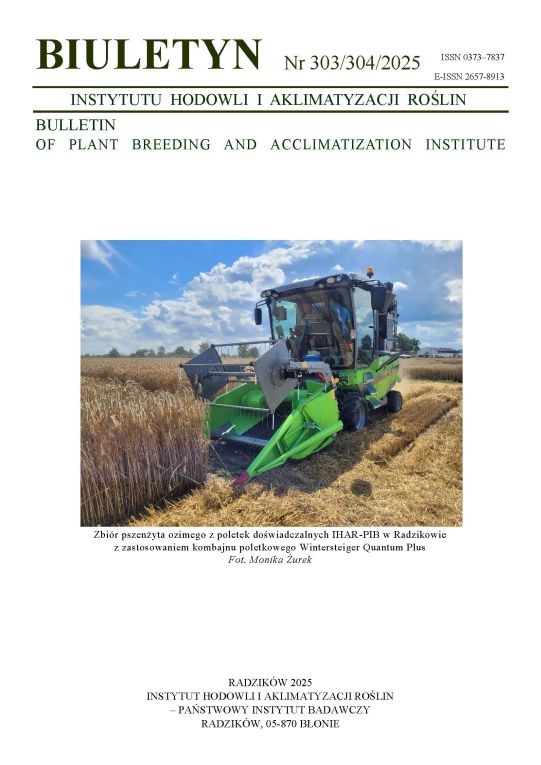Reakcja wybranych odmian pszenicy ozimej na uprawę w systemie ekologicznym
Jarosław Stalenga
iung@iung.pulawy.plZakład Systemów i Ekonomiki Produkcji Roślinnej, Instytut Uprawy Nawożenia i Gleboznawstwa — PIB, Puławy (Poland)
Krzysztof Jończyk
Zakład Systemów i Ekonomiki Produkcji Roślinnej, Instytut Uprawy Nawożenia i Gleboznawstwa — PIB, Puławy (Poland)
Abstrakt
W pracy oceniono reakcję wybranych odmian pszenicy ozimej na uprawę w systemie ekologicznym. Przeprowadzone badania obejmowały analizę i ocenę plonowania, nagromadzania suchej masy, stanu odżywienia azotem oraz dynamiki zmian wskaźnika pokrycia liściowego (LAI). Do badań wykorzystano doświadczenie polowe założone w 1994 roku w Stacji Doświadczalnej IUNG-PIB w Osinach, którego celem jest porównywanie różnych systemów produkcji roślinnej. Badania prowadzono w latach 2003–2005 na polu pszenicy ozimej w systemie ekologicznym o powierzchni 1 ha, na glebie zaliczanej do kompleksu żytniego dobrego. W doświadczeniu testowano sześć odmian pszenicy ozimej (Kobra, Roma, Korweta, Sukces, Zyta, Mewa) oraz odmianę Schwabenkorn pszenicy orkisz. Dodatkowo w 2005 roku do uprawy w systemie ekologicznym, oprócz dotychczasowych odmian, wprowadzono 3 tzw. „stare” odmiany pszenicy ozimej: Ostkę Kazimierską, Kujawiankę Więcławicką, Wysokolitewkę Sztywnosłomą. Największe i najbardziej stabilne plony spośród testowanych odmian średnio w całym okresie badań uzyskiwała odmiana Mewa — 4,27 t/ha oraz Sukces — 4,21 t/ha. Odmiany „współczesne” plonowały średnio o około 2 t/ha wyżej niż tzw. odmiany „stare”. Największą akumulację suchej masy zanotowała wysoko plonująca odmiana Zyta, a także pszenica orkisz. Najwyższą wartością wskaźnika LAI charakteryzowała się pszenica orkisz, a także „stare” odmiany pszenicy ozimej. Spośród porównywanych odmian najlepszym stanem odżywienia azotem charakteryzowała się odmiana Mewa. Uzyskane wyniki badań wskazują, iż odmianami bardziej przydatnymi do uprawy w rolnictwie ekologicznym są oścista odmiana Mewa, a także jakościowe odmiany Zyta i Sukces. Pszenica orkisz, ze względu na wiele korzystnych cech wydaje się mieć korzystne perspektywy rozwoju w rolnictwie ekologicznym, choć z drugiej strony jej mała mrozoodporność stwarza istotne ograniczenia w jej rozpowszechnieniu w naszym kraju.
Słowa kluczowe:
rolnictwo ekologiczne, dobór odmian, pszenica ozimaBibliografia
Bergmann W. 1992. Nutritional disorders of plants: development, visual and analytical diagnosis. Gustav Fischer Verlag Jena, Stuttgart, New York.
Google Scholar
Eisele J. A., Köpke U. 1997. Choice of cultivars in organic farming: new criteria for winter wheat ideotypes. Pflanzenbauwissenschaften 1 (1): 19 — 24.
Google Scholar
Feledyn-Szewczyk B., Duer I. 2006. Ocena konkurencyjności odmian pszenicy ozimej uprawianej w ekologicznym systemie produkcji w stosunku do chwastów. J. Res. Applic. Agricult. Eng. 51(2): 30 — 35.
Google Scholar
Fotyma E., Pecio A. 1999. Zależność pomiędzy zawartością azotu a nagromadzaniem suchej masy przez zboża. Pam. Puł. 114: 93 — 100.
Google Scholar
Fotyma E. 2002. Zróżnicowanie odmianowe zawartości chlorofilu w liściach zbóż ozimych. Pamiętnik Puławski 130: 171 — 178.
Google Scholar
Jończyk K. 2002. Reakcja wybranych odmian pszenicy ozimej na uprawę w różnych systemach produkcji roślinnej. Pam. Puł. 130/I: 339 — 345.
Google Scholar
Kuś J., Mróz A., Jończyk K. 2006. Nasilenie chorób grzybowych wybranych odmian pszenicy ozimej w uprawie ekologicznej. J. Res. Applic. Agricult. Eng., 2006, 51 (2): 88 — 93.
Google Scholar
Leibl M., Petr J. 2000. Varieties of winter wheat for ecological farming. In: Proc. of the 13th Int. IFOAM Scien. Conf. in Basel. Vdf Hochschulverlag AG an der ETH Zurich: 243.
Google Scholar
Lemaire G., Gastal F. 1997. N uptake and distribution in plant canopies. In: Lemaire G. (ed.) Diagnosis of the nitrogen in crops. Springer-Verlag Berlin Heidelberg: 3 — 43.
Google Scholar
Lista opisowa odmian. 2003. COBORU, Słupia Wielka.
Google Scholar
Stalenga, J. 2002. Zastosowanie testu SPAD do oceny stanu odżywienia azotem pszenicy ozimej w różnych systemach produkcji roślinnej. Nawozy i Nawożenie 2 (11): 137 — 144.
Google Scholar
Stalenga J. 2007. Applicability of different indices to evaluate nutrient status of winter wheat in the organic system. Journal of Plant Nutrition 30 (3): 351 — 365.
Google Scholar
Autorzy
Jarosław Stalengaiung@iung.pulawy.pl
Zakład Systemów i Ekonomiki Produkcji Roślinnej, Instytut Uprawy Nawożenia i Gleboznawstwa — PIB, Puławy Poland
Autorzy
Krzysztof JończykZakład Systemów i Ekonomiki Produkcji Roślinnej, Instytut Uprawy Nawożenia i Gleboznawstwa — PIB, Puławy Poland
Statystyki
Abstract views: 158PDF downloads: 122
Licencja
Prawa autorskie (c) 2007 Jarosław Stalenga, Krzysztof Jończyk

Utwór dostępny jest na licencji Creative Commons Uznanie autorstwa – Na tych samych warunkach 4.0 Miedzynarodowe.
Z chwilą przekazania artykułu, Autorzy udzielają Wydawcy niewyłącznej i nieodpłatnej licencji na korzystanie z artykułu przez czas nieokreślony na terytorium całego świata na następujących polach eksploatacji:
- Wytwarzanie i zwielokrotnianie określoną techniką egzemplarzy artykułu, w tym techniką drukarską oraz techniką cyfrową.
- Wprowadzanie do obrotu, użyczenie lub najem oryginału albo egzemplarzy artykułu.
- Publiczne wykonanie, wystawienie, wyświetlenie, odtworzenie oraz nadawanie i reemitowanie, a także publiczne udostępnianie artykułu w taki sposób, aby każdy mógł mieć do niego dostęp w miejscu i w czasie przez siebie wybranym.
- Włączenie artykułu w skład utworu zbiorowego.
- Wprowadzanie artykułu w postaci elektronicznej na platformy elektroniczne lub inne wprowadzanie artykułu w postaci elektronicznej do Internetu, lub innej sieci.
- Rozpowszechnianie artykułu w postaci elektronicznej w internecie lub innej sieci, w pracy zbiorowej jak również samodzielnie.
- Udostępnianie artykułu w wersji elektronicznej w taki sposób, by każdy mógł mieć do niego dostęp w miejscu i czasie przez siebie wybranym, w szczególności za pośrednictwem Internetu.
Autorzy poprzez przesłanie wniosku o publikację:
- Wyrażają zgodę na publikację artykułu w czasopiśmie,
- Wyrażają zgodę na nadanie publikacji DOI (Digital Object Identifier),
- Zobowiązują się do przestrzegania kodeksu etycznego wydawnictwa zgodnego z wytycznymi Komitetu do spraw Etyki Publikacyjnej COPE (ang. Committee on Publication Ethics), (http://ihar.edu.pl/biblioteka_i_wydawnictwa.php),
- Wyrażają zgodę na udostępniane artykułu w formie elektronicznej na mocy licencji CC BY-SA 4.0, w otwartym dostępie (open access),
- Wyrażają zgodę na wysyłanie metadanych artykułu do komercyjnych i niekomercyjnych baz danych indeksujących czasopisma.
Inne teksty tego samego autora
- Jan Kuś, Jarosław Stalenga, Perspektywy rozwoju różnych systemów produkcji rolniczej w Polsce , Biuletyn Instytutu Hodowli i Aklimatyzacji Roślin: Nr 242 (2006): Wydanie regularne
- Krzysztof Jończyk, Andrzej Kawalec, Wstępna ocena przydatności wybranych odmian pszenicy ozimej do uprawy w różnych systemach produkcji roślinnej , Biuletyn Instytutu Hodowli i Aklimatyzacji Roślin: Nr 220 (2001): Wydanie regularne














